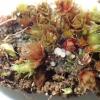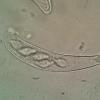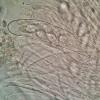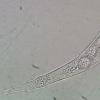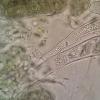
09-11-2025 13:20
Hello.A tiny ascomycete, appearing as erupting gra

08-11-2025 00:29
 Francois Guay
Francois Guay
I found this species in Quebec, Canada, on herbace

04-11-2025 09:07
Hello.A suspected Hymenoscyphus sprouting on a thi

04-11-2025 12:43
 Edvin Johannesen
Edvin Johannesen
Hi! One more found on old Populus tremula log in O

03-11-2025 21:34
 Edvin Johannesen
Edvin Johannesen
These tiny (0.4-0.5 mm diam.), whitish, short-stip
Bryoscyphus?
Georges Greiff,
06-01-2021 14:22
Hi All,
I found a whitish species on sandy soil with Bryum capillare and Ceratodon purpureus. I believed it was Bryoscyphus dicrani in the field but the (unliberated) ascospores do not seem to fit that taxon and the paraphyses appear to lack the distinctive vacuolar bodies present in many fresh collections of Bryoscyphus spp. I wonder if it fits Bryoscyphus "rhombispora" nom prov. Baral. I do not have enough good material for a good quantitative analysis but the ascospore dimensions are approx. 17-20 x 8-10, which seems too large. Found in South England.
Any thoughts or resources would be greatly appreciated. I can't seem to find Zotto's image gallery, which I recall has excellent images of Bryoscyphus spp.
Thanks,
Georges
Georges Greiff,
06-01-2021 14:25
Re : Bryoscyphus?
Ah, I think it is Mniaecia nivea...
Lothar Krieglsteiner,
06-01-2021 14:47

Re : Bryoscyphus?
Yes, this seems more likely (or a related form). The paraphyses are not multiguttulate as they should be in Bryoscyphus.
Best, Lothar
Best, Lothar

